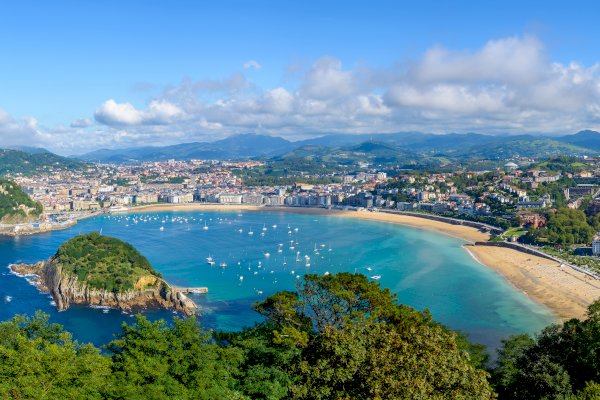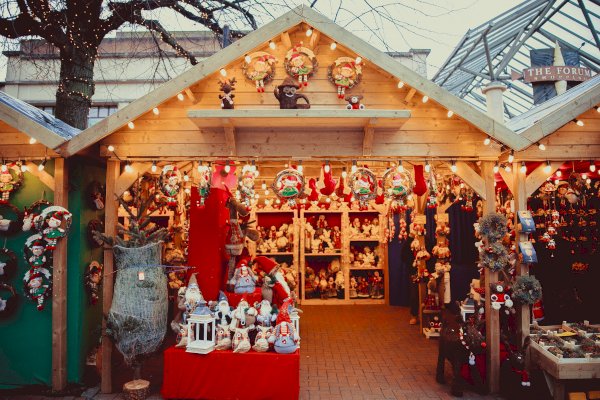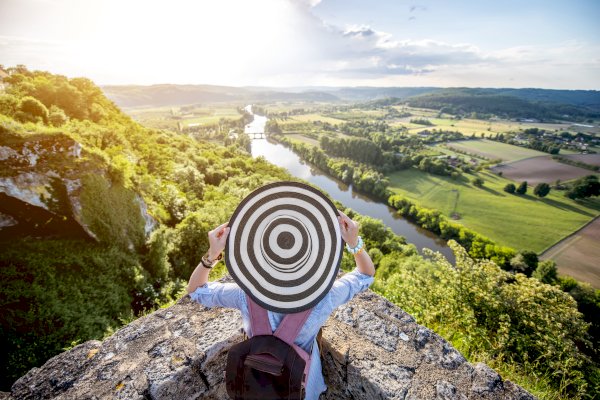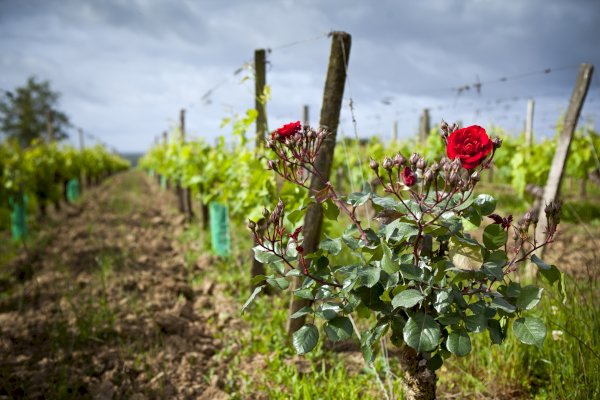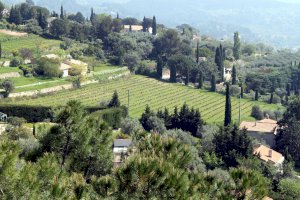
The 5 Most Famous Bordeaux Wine Appellations

THE 5 MOST FAMOUS WINE REGIONS OF BORDEAUX
1 – Margaux
The Soul of Bordeaux
Immediately north of Bordeaux lies the vast peninsula of Médoc, squeezed between the Atlantic Ocean and the Garonne River. This is the realm of Cabernet Sauvignon grape variety. Along the course of the Garonne we follow the "route des châteaux" or, the châteaux road, passing by the famous wine estates that make great Bordeaux in the world. Immediately we arrive to Margaux appellation, one of the largest in the region.
The landscape is rural, interspersed with farms and livestock. Right in the centre lies the village of Margaux itself, whose life revolves entirely around the production of wine. Out of 68 producers, 21 belong to the group of the 61 Grands Crus Classes 1855. Many others are classified as Crus Bourgeois or Crus Artisans, all distinctions allowed to absolute quality.
Style: red dry wine
Soil: Home to the best vineyards in the area, the gentle clay-limestone hills popping up here and there are covered with a thick layer of sedimentary sand and alluvial pebbles brought by the river during the glaciations.
Sand and slopes guarantee well-drained soils, vital assets in the local oceanic and rainy climate. Moreover, the pebbles accumulate sun’s light heat during the day then releasing it during the cool autumn evenings and thus protecting the grapes ripening.
Microclimate: the Margaux appellation enjoys one of the best climatic conditions in Bordeaux area: the proximity to the river limits spring frosts episodes while the relative distance from the ocean protects the vineyards from the storms. All this guarantees a remarkable both qualitative and quantitative continuity over the vintages, setting Margaux appellation the hearth of Bordeaux production.
The wines: The blend often sees Cabernet Sauvignon and Merlot grapes used in almost equal parts. While Cabernet Sauvignon gives more structure and aromatic persistence, Merlot adds fruity and seductive components. A small percentage of Petit Verdot guarantees a spicy character.
The wines are characterized by rare softness and an exceptional finesse. They own an aromatic, delicate and complex bouquet that harmoniously blend fruity (raspberry, cherry, red currant), floral (pot-pourri, hyacinth) and toasted flavours (cedar, vanilla). These are undoubtedly the most elegant wines of Bordeaux, excellent for ageing and easy to pair with food.
Reference producer: Château Margaux (of course!)
Fun fact: Margaux wines have been famous for centuries around the world and they have been the favourites of many VIPs such as Benjamin Franklin and Thomas Jefferson who personally visited Margaux. Discover all our wine tours to the Margaux appellation on our day trips from Bordeaux to the Médoc wine region.
2 – Pauillac
An iron fist in a velvet glove
Continuing northwards along the “route des châteaux” we reach Pauillac, the capital town of Médoc. Only 3500 inhabitants here but it hosts 88 producers, including 18 Grands Crus Classes 1855. Pauillac is a small port on the estuary of the great river Gironde created by the confluence of the Dordogne flowing from the east and from Libourne, and the Garonne from the south and from Bordeaux. Pauillac stands at the foot of massive clay-limestone mounds covered with sand and pebbles. Here no other cultivation could flourish while vine trees find an ideal environment.
Style: red dry wine
Soil: The best plots are located on top of the sandy mounds covered with sedimentary pebbles. Here, the vines are forced to search for nutrients and water by pushing their roots as deep as possible. The overall drainage potential is very high, and this guarantees juice concentration to the grapes even in the local rainy oceanic climate.
Microclimate: Oceanic influences are strong all along the Gironde river. Spring is very rainy, while summer is sunny and breezy. In autumn, strong temperature variations between the humid and cold nights and warm-sunny days create the ideal conditions for grapes maturity, offering great aromatic strength joined by powerful and velvety tannins.
The Wines: Pauillac produces rich, dense, and deep coloured wines that, at the same time, show great elegance and possess aromas of great delicacy. Their aromatic scale includes notes of cherry, cassis (black currant), liquorice, dog rose, cedar, toasted tobacco, and incense. The tannins are dense but not harsh. In general, these wines need time and ageing to be fully appreciated. The blend is largely composed of Cabernet Sauvignon and, to a lesser extent, Merlot. In small percentages Petit Verdot and Malbec add spicy notes and depth of colour.
Reference producers: Château Lafite Rothschild, Château Mouton Rothschild, Château Latour
Fun fact:
Every year, the second Saturday of September, starts from Pauillac, the “Médoc Marathon”. Known throughout the world, the race passes through the most prestigious vineyards and estates of Médoc.
On the day of the marathon, more than 90% of the participants come to the start line masked for what is a kind of colourful carnival train. Waiting for them there are 52 areas set for entertainment, 22 as refreshment points, plus another twenty or so host refection with oysters, sausages, steaks, cheeses, ice creams and, of course, wine tastings sponsored by the grands crus. Lap time is not the goal, what matters is pleasure and tasting (with moderation!).
Discover the Pauillac appellation on our full day private or shared Médoc wine tour from Bordeaux.

3 – Sauternes
The gold of Bordeaux
At the southern end of the Bordeaux vineyard, about forty kilo-meters from the city, opens the appellation Sauternes, undisputed kingdom of the sweet white wines. This is one of the oldest wine-growing areas in the region and in entire France. Here, rolling hills rise between the great Garonne River and its fast Ciron tributary, dotted with impressive châteaux in the middle of an endless expanse of vineyards.
The best moment of the year to visit Sauternes is on October, when the vines leaves turn to an intense yellow with green and brown reflections. The whole landscape then takes on a golden hue just like the local wines colour. Far from the big urban centres, quiet in the countryside, if you are looking for calm, good food and unique wines, Sauternes is the place for you.
Style: sweet white wine
Soil: Clayey-calcareous hills covered by a deep sandy layer, ideal conditions for the wine’s aromatic development. The high-water drainage potential guarantees grapes concentration.
Microclimate: After a dry and sunny summer, on September and October, harvesting time, the Ciron river plunges its cool waters into the slower and warm Garonne creating a thick morning fog covering the vineyards. This allows the development of the famous Botrytis Cynerea, a noble rot responsible for the famous wines of Sauternes.
The Wines: The Sauternes are characterized by an ancient-gold colour evolving with age towards dark yellow amber. On the nose they are incredibly complex and balanced, harmoniously mixing notes of wildflowers, almonds, hazelnuts, quince, and beeswax but also mango, pineapple, peach in syrup, dehydrated apricot and much, much more.
The impressive aromatic presence is found on the palate with an extraordinary viscosity and an extreme balance between residual sugars and a soft acidity of fresh fruit. The finish often shows an incomparable length. The blend is dominated by the fruity Semillon grape, associated with the fresh and floral Sauvignon Blanc. Limited today is the use of more rustic Muscadelle.
Reference producer: Château d’Yquem
Fun fact: Nowadays sweet white wines find limited occasions to be on display, often consumed only during Christmas period. Since a few years the Sauternes wines find new visibility thanks to the most creative barmen who started to mix them as an ingredient for their cocktails.
We organize both private and shared day trips & wine tours from Bordeaux to Sauternes.

4 – Pomerol
At the gates of heaven
The Pomerol area has got ancient viticulture traditions, dating back to Roman times, but it is only from the Middle Ages that the Templar knights installed here a commanderie, or a small hospital for sheltering and assisting the many pilgrims on their way to Santiago de Compostela. The Templars also engaged themselves to wine production and this is the reason why many châteaux in Pomerol still celebrate this glorious past taking inspiration for their names directly from the Christian religion.
The appellation area is the smallest in the Bordeaux, with only 800 hectares of vineyards, but the producer’s density is very high with about 140 proprieties. From outside these estates look like modest country houses and the village itself is crossed by busy winemakers with dirty boots from the local precious land.
Don't be fooled though: away from the spotlight, in a religious calm, here are produced some of the most remarkable (and expensive!) wines in the world. Pomerol is the only major Bordeaux appellation that does not include a classification of its wines: no Cru or Grand Cru indication, here on the label you are going just to find written "Pomerol".
Style: red dry wines
Soil: The reference soil is located on top of the famous Pomerol plateau where there is a singular concentration of the blue clay playing so much part in the appellation success. This clay possesses a very high potential for water retention and, as rainfall varies, it tends to alternatively expand and contract, allowing the vines roots to penetrate deeply down the ground.
Other soils of this complex terroir are sand, limestone pebbles and iron cast. A unique composition in the world where the Merlot grape finds its maximum expression.
Microclimate: Oceanic and temperate, mitigated by the influences of the Dordogne River that flows right in front of the appellation. Summers are hot and sunny, granting perfect grapes ripeness. On September, at the time of harvest, rain can cause serious damages.
The Wines: Blend is mainly based on the exuberant Merlot, regularly associated with small percentages of the wiser Cabernet Franc. Pomerol wines show an exceptional aromatic power, linked to particularly velvety tannins. T
he rich aromatic set is centred on red berries, violet, put-pourri and, with ageing it gains hints of black truffles and game. The mouth is wide and sensual, fleshy, hiding great power. These wines can be tasted young, but they express all their potential and finesse after an ageing process that does not fear time.
Reference producer: Petrus
Fun fact: All the events organized to promote the Pomerol terroir and, more generally, Bordeaux wines, see the participation of the Hospitallers of Pomerol. This brotherhood evokes the presence of the Templars knight’s hospital present here during the Middle Ages and kept alive by the Malta Order starting from 1317.
Nowadays no knights any more here around but the new Hospitallers of Pomerol aim to keep alive this glorious past so, when “on duty”, this group of winemakers, traders and professionals wear a large red robe decorated with a big Maltese cross and a Santiago de Compostela shell set in the middle.
Such as the ancient knights protected the pilgrims on their way, this modern confraternity is now concerned with perpetuating the tradition of the hospitality in Pomerol, raising the banner of the appellation throughout the world. Discover the magic of Pomerol wines on our private tours of the right bank wine region of Bordeaux.

5 – Saint-Emilion
Past, present, and future of Bordeaux
The Saint-Emilion vineyard has been classified in the UNESCO list as a natural and cultural heritage of humanity since 1999. This affirmation consecrates an exceptional viticulture territory, where the vineyard is organized as an amphitheatre on top of a large limestone plateau dotted with hundreds of wine estates.
In the centre, the medieval village is one of the best preserved and beautiful of France. A small architectural jewel to be explored walking among historic buildings and enchanting streets. Get ready to pleasantly wander around, taking an eye on the many well-furnished wine cellars or, for an unforgettable meal, sitting down in some of the region’s best restaurants.
Style: red dry wines
Soil: The terroir includes roughly four types of soils composed by two main groups. The first is the limestone plateau with its steep clay-limestone slopes: here the most powerful and concentrated wines can be made. The two remaining areas host the fine and aromatical wines production: the first set to north west, where can be found sand covering rather clayey soils. The last one lies on the south west, between the village and the Dordogne river, in the alluvial valley covered by sedimentary sands.
Microclimate: The same as in Pomerol, located in the immediate surroundings. The main difference is that here in Saint-Emilion the top of the plateau is protected from late spring frosts episodes.
The wines: Cabernet Franc is coming back strongly in the blend, after decades as a secondary partner for the more expressive Merlot. Global warming may even open new possibilities to the bolder member of the family: The Cabernet Sauvignon. Wines here have an intense purplish colour when young and showing to the nose hints of strawberry and ripe plum, but also baked spices, vanilla, leather, and smoky notes. Saint-Emilion wines are generous, powerful, and warm. In the mouth they offer solid but velvety tannins that guarantee a remarkable longevity and a complex aromatic development.
Saint-Emilion Grands Crus
Saint-Emilion hosts one of the most prestigious classifications in France. This started in 1954 when the so called "Saint-Emilion Grand Cru" appellation system was overlap to the basic "Saint-Emilion". You find here two appellations in one! Thanks to that, the producers who submit to more stringent quality rules may be able to become part of the prestigious Grands Crus club, and then proudly display it on their labels. After that, they can even start to climb the official classification of Saint-Emilion to become "Saint-Emilion Grands Crus Classés". The jury appointed to select the candidates is reunited every then years and considers the wines consistency over the years, the specific location of each vineyard and the international prestige acquired.
Reference Producer : Château Cheval Blanc, Château Ausone
Fun fact: The sights of Saint-Emilion do not end at the surface: in addition to the UNESCO landscape and the medieval village, even the subsoil hides its own treasures. Indeed, the large limestone plateau is crossed by two hundred kilometres of tunnels, dug over the centuries to extract material for buildings.
Today a few châteaux use these spaces to store their stock of wines, taking advantage from the perfect temperature conditions and constant humidity all year round. Visiting these underground cellars is an experience cannot to be missed! Let our expert guides introduce you to the village & wines of Saint Emilion on a full day trip from Bordeaux.


Secured payments

easy cancellation

 Please wait
Please wait










